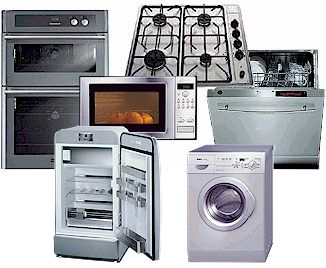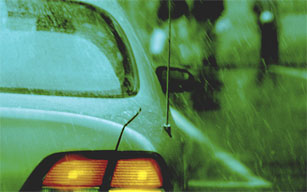Though accidents sometimes happen, there are precautions that people can take to make their homes as safe as possible. Kitchen and home appliances can lead to fires and serious injuries if the proper precautions are not taken. Sometimes fires get out of control and can injure people and/or severely damage a home. Fortunately, there are several things that people can do to lessen the chance of a fire, electrical mishap, or other injury connected with a home or kitchen appliance.
Be Prepared
It is important to always be prepared for a home emergency, such as a fire or injury that occurs at home. A very simple and effective step to take in being prepared is to keep a fire extinguisher in or near the kitchen. Fire extinguishers must be inspected periodically to make sure that they are in working order. All homes should also have smoke detectors with working batteries, preferably in each room of the home. It’s necessary to check smoke detectors on a regular basis to be sure that they are operational. Carbon monoxide detectors are also a wise investment for a household, as they can help to ensure your family's safety.
In addition, all households should have an escape plan in place, in the event of a house fire. Sitting down with family members and discussing the plan will allow everyone to learn how to get out, as well as where to meet in the case of an emergency. Young children should be shown how to telephone for help and what to say to the 911 operator if a parent or sibling is injured or there is another emergency. These are all small ways to prepare one's family for a home emergency, and could potentially pay off in the long run.
Large Appliances
Most households contain several large appliances. Refrigerators, ovens, washers, clothes dryers, and dishwashers are just a few items that fall into the large appliance category. Each appliance should come with instructions upon purchase, as well as safety guidelines, that should be read and kept for reference.
Large appliances gather lots of dust that can eventually become a safety hazard if the dust gathers excessively. Any dust and dirt should be periodically cleaned off of vents at the bottom of refrigerators to allow these appliances to run more easily. Also, the lint screen of a clothes dryer must be cleaned of dust and dirt after every load of clothing. A build-up of lint can contribute to a fire in a laundry room.
The electrical cord of large appliances should also be checked from time to time for fraying and other safety hazards. A cord on any large appliance needs to remain intact in order for it to be safe. If there is a tear or fray on an electrical appliance, discontinue using it until the cord is properly fixed by a licensed electrician.
The dishwasher in a home must also be checked periodically to see that it is in good working order. Sometimes if water isn’t draining properly, or if there is a problem with water intake, the dishwasher can potentially heat up, leading to problems.
In regard to ovens, they should be cleaned regularly to avoid a build-up of burnt food on the floor of the appliance. Oven gloves and pot holders (along with any other flammable objects) should be kept clear of the stovetop so as to avoid falling on top of a hot burner and causing a fire. Oven locks should be used if there are children in the household, to avoid a little one opening an oven door and getting hurt.
Many of these safety precautions are fairly simple to put into practice, and simply require periodic inspection to ensure that they are in safe, working order. One can never be too safe when it comes to home and kitchen appliances.
Smaller Appliances
Microwaves, toasters, toaster ovens, coffee makers, and electric mixers are all considered small appliances. Not surprisingly, there are a number of safety precautions connected with them. Once again, the electrical cords of these appliances must be maintained, and should not be used if these cords are frayed or otherwise damaged. As a rule of thumb, all small electric appliances should be kept clear of water sources (such as sinks and faucets), as these can pose serious safety risks when working with electricity.
When it comes to microwave ovens, it is important to never put metal inside one. This may include (but is not limited to) metal dishes, utensils, foils, etc. Always check to see if a dish has a ‘microwave safe’ label printed on it before reheating it. Also, if a microwave is problematic or unreliable in heating food, take it to a professional to see if it needs to be repaired.
Toasters and toaster ovens also can pose a safety hazard if not used correctly. For one, never stick a fork or any other utensil into a toaster that is plugged in. This is a very dangerous action that can lead to electrical shock. Toasters and toaster ovens should also be kept clear of any objects or surfaces that may be flammable or may melt, as they tend to become very hot.
Electric mixers can also become safety hazards if used improperly. When using a mixer, it is important to check to see whether the mixer is turned on before plugging it in. If the mixer turns on as it is plugged in, there’s a risk that someone’s fingers or clothing may get caught in the beaters.
Each of these safety precautions is fairly simple and straightforward. Individuals should follow these simple guidelines to help ensure that their homes remain safe havens, free of hazards. Following are some helpful resources that include further information on keeping one's home safe.
-
Product Recall Information and More: Read information on product recalls of appliances and more, provided by the Consumer Product Safety Commission.
-
Appliance Safety Reminders: Learn several important safety guidelines and reminders regarding appliance fires.
-
Microwave Safety: Checkout the section that offers information on what sorts of containers to use in a microwave oven.
-
Tips for Electrical Safety: Find a list of tips of how to stay safe around electrical appliances.
-
Safety in the Kitchen: The guidelines on this page include both toaster and stove safety tips.
-
Safety Tips for Appliances that Provide Heat: (PDF) Discover safety facts about wood stoves, kerosene heaters, and generators on this helpful page.
-
Safety Information Concerning Microwaves and Clothing Dryers: (PDF) Peruse lots of information including how to prevent fires related to a clothing dryer.
-
Preventing Kitchen Fires: Keeping towels away from the stovetop and checking electrical cords for rips are just two of the safety reminders listed on this page.

 Home and Kitchen Appliance Safety
Home and Kitchen Appliance Safety Many residents of Westchester County have experienced the damages that flooding can produce.
Many residents of Westchester County have experienced the damages that flooding can produce.